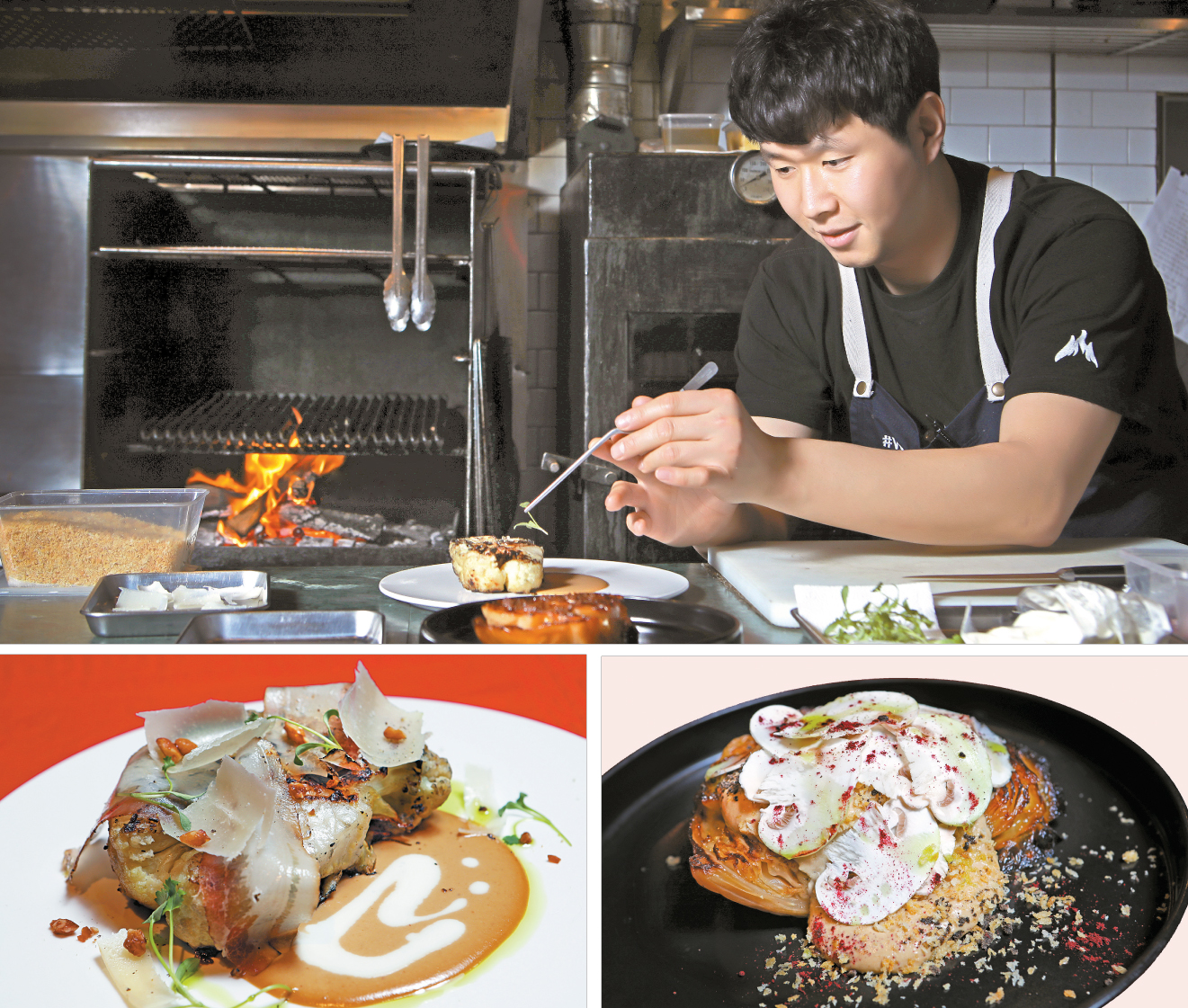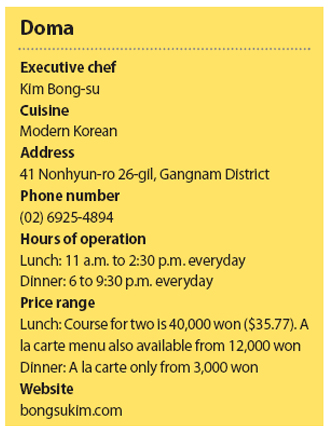Diving deep into Korean cuisine’s many flavors

Chef Kim Bong-su, top, of restaurant Doma in Dogok-dong, southern Seoul, plates his dish. Some of the vegetables he grilled on a wood fire include cauliflower, above left, and cabbage, above right. [PARK SANG-MOON]
Kim, the brains in the kitchen at Doma in Dogok-dong, southern Seoul, has chosen wood-based fires as the latest technique he wants to master. For the chef, whose interests lie in cooking what can be considered Korean food, using methods that bring out local ingredients’ taste, especially that of vegetables, is crucial.
One way to do so is by using a wood fire. While most people associate grilling with meat when it comes to Korean cuisine, the technique is also widely used to cook vegetables. Kim gets to freely experiment with different grilling techniques thanks to the relationship the restaurant he works at has with its sister brand, which specializes in butchering. He hopes to show customers that relatively cheaper ingredients - such as carrots and sweet potatoes - can also have a fuller flavor profile when grilled.
One of the ingredients he has recently worked on is cabbage. He wanted to bring out cabbage’s sweetness, and simply grilling it in a pan or steaming it in a pot didn’t satisfy him. Kim wanted a deep, yet clean sweetness, so he slow-cooked cabbage covered in smoked oil for five hours. Then he added doenjang (fermented soy bean paste) made into a foam, to top the whole thing with a savory taste. After years of using wood fires, he has developed his own skills for controlling them, and knows exactly how quickly or slowly the ingredients need to be cooked.

Ever since Kim started his professional career, his interest in Korean food has only deepened. The first restaurant he worked in was Seoul’s Jungsik, which is often considered one of the first spots to have put Korean dishes in the form of a Western-style course meal. He even joined the team for three months in New York when the restaurant’s branch there opened to see how Korean flavors fared in the gastronomic capital. The inspiration he received while in New York led him to travel the Korean Peninsula in search of unique ingredients he could use before other chefs could find them. In the process, Kim joined Mr. Ahn’s Makgeolli, which matches Korean food with Korean liquor in an attempt to show local ingredients’ competitiveness.
“I was ashamed that there was little I could share about Korean ingredients and seasonings when chefs in Australia asked me [about them] when I was working there,” said Kim. “I started to think more about making food that may not look like Korean food but taste like it.”
Kim’s passion for food was reconfirmed when he entered San Pellegrino Young Chef, an international competition organized by the water company in 2017. During the event, he felt the need to focus more on studying Korean food after seeing a Taiwanese competitor name his dish “Taste of Taiwan.” He started thinking about how much he knew about food from the country he was born in and felt the need to do more in order to confidently call himself a chef who cooks Korean food.
Naturally, he started to choose one concept to focus on at a time, sharing his process on social media. His intense study of certain kitchen methods has become a part of his brand.
“No one ever forced me to [create a] brand [for] myself, but the things I was interested in naturally became part of my brand,” said Kim, adding that he thinks it is important that he share what he learns with others.
“There are just so many things I feel sad to just know myself and only myself. The life of [a chef] is to share things so that more people can be inspired to have new experiences and try new food.”
While most of the chefs introduce themselves through their restaurants’ websites, Kim felt the need to show how he has evolved after years of cooking in different places. He set up a personal website last year to post events he has done and places he has worked using photos he has collected over the years.
Kim’s biggest dream is to open a restaurant in his hometown Yangyang, Gangwon. Unlike a restaurant in the center of a city people go to for just one meal, his dream spot would have other facilities where people can stay overnight while doing relaxing activities, such as bathing or taking walks.
He even once talked with a fellow chef about their dream restaurant in which diners move to different spots around the space to eat things that complement a nearby beach, a view of mountains in the distance or a garden in front of the restaurant.
“I hope I can provide something more than just food, so that the dining experience can be something wholesome and relaxing,” said Kim.
BY LEE SUN-MIN [summerlee@joongang.co.kr]










with the Korea JoongAng Daily
To write comments, please log in to one of the accounts.
Standards Board Policy (0/250자)